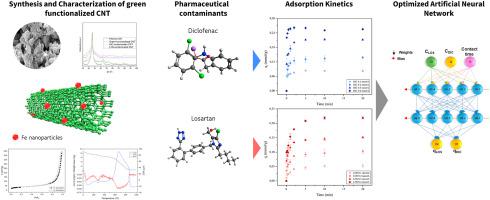当前位置:
X-MOL 学术
›
Environ. Res.
›
论文详情
Our official English website, www.x-mol.net, welcomes your feedback! (Note: you will need to create a separate account there.)
Green synthesis of carbon nanotubes functionalized with iron nanoparticles and coffee husk biomass for efficient removal of losartan and diclofenac: Adsorption kinetics and ANN modeling studies
Environmental Research ( IF 8.3 ) Pub Date : 2024-03-21 , DOI: 10.1016/j.envres.2024.118733 Heloisa P.S. Costa , Emanuele D.V. Duarte , Flávio V. da Silva , Meuris G.C. da Silva , Melissa G.A. Vieira
Environmental Research ( IF 8.3 ) Pub Date : 2024-03-21 , DOI: 10.1016/j.envres.2024.118733 Heloisa P.S. Costa , Emanuele D.V. Duarte , Flávio V. da Silva , Meuris G.C. da Silva , Melissa G.A. Vieira

|
The presence of emerging contaminants in wastewater poses a global environmental challenge, requiring the development of innovative materials or methods for their treatment. This study focused on the production of green functionalized carbon nanotubes (CNTs) and using them in the adsorption of the pharmaceuticals Losartan (LOS) and Diclofenac (DIC). The efficiency of the methodology was verified by characterization techniques. Elemental composition analysis indicated a significant increase in the iron content after the green functionalization, proving the effectiveness of the method. Thermogravimetric analysis showed similar thermal degradation profiles for pristine CNTs and functionalized CNTs, indicating better post-functionalization thermal stability. BET analysis revealed mesoporous characteristics of CNTs, with increased surface area and pore volumes after functionalization. X-Ray diffraction confirmed the preservation of the lattice structure of the CNTs post-functionalization and post-adsorption, with changes in peak broadening suggesting surface modifications. LOS and DIC adsorption were evaluated via kinetic studies at four different concentrations (0.1–0.4 mmol/L) that were best represented by the pseudo-second order model, suggesting chemisorption mechanisms, with faster and higher uptakes for DIC (0.084–0.261 mmol/g; t = 5 min) when compared to LOS (0.058–0.235 mmol/g; t = 20 min). The curves were also studied via artificial neural networks (ANN) and revealed that the best ANN architecture for representing the experimental data is a network with [3 5 5 2] neurons trained using the Bayesian-Regularization algorithm and the Log-sigmoid (hidden layers) and Linear (output layer) transfer functions. The desorption study showed that CaCl had better performance in CNT regeneration, reaching its removal capacity above 50% up to 3 cycles, for both pharmaceuticals. These findings reveal the potential of the developed material as a promising adsorbent for targeted removal of pollutants, contributing to advances in the remediation of emerging contaminants and the application of artificial intelligence in adsorption research.
中文翻译:

用铁纳米粒子和咖啡壳生物质功能化的碳纳米管的绿色合成,用于有效去除氯沙坦和双氯芬酸:吸附动力学和人工神经网络建模研究
废水中新出现的污染物的存在构成了全球环境挑战,需要开发创新材料或方法来处理这些污染物。本研究重点关注绿色功能化碳纳米管(CNT)的生产并将其用于药物氯沙坦(LOS)和双氯芬酸(DIC)的吸附。通过表征技术验证了该方法的效率。元素成分分析表明绿色功能化后铁含量显着增加,证明了该方法的有效性。热重分析显示原始碳纳米管和功能化碳纳米管的热降解曲线相似,表明功能化后热稳定性更好。 BET 分析揭示了碳纳米管的介孔特性,功能化后表面积和孔体积增加。 X射线衍射证实了碳纳米管在功能化和吸附后晶格结构的保存,峰展宽的变化表明表面修饰。通过四个不同浓度(0.1-0.4 mmol/L)的动力学研究评估了 LOS 和 DIC 吸附,这些浓度最好由伪二阶模型表示,表明化学吸附机制,DIC 的吸收更快、更高(0.084-0.261 mmol/L)。 g;t = 5 分钟)与 LOS(0.058–0.235 mmol/g;t = 20 分钟)相比。还通过人工神经网络 (ANN) 对曲线进行了研究,结果表明,表示实验数据的最佳 ANN 架构是使用贝叶斯正则化算法和 Log-sigmoid(隐藏层)训练的 [3 5 5 2] 神经元网络)和线性(输出层)传递函数。解吸研究表明,CaCl 在 CNT 再生方面具有更好的性能,对于两种药物而言,在 3 个循环内其去除能力均达到 50% 以上。这些发现揭示了所开发的材料作为有前景的吸附剂用于有针对性地去除污染物的潜力,有助于新兴污染物的修复和人工智能在吸附研究中的应用取得进展。
更新日期:2024-03-21
中文翻译:

用铁纳米粒子和咖啡壳生物质功能化的碳纳米管的绿色合成,用于有效去除氯沙坦和双氯芬酸:吸附动力学和人工神经网络建模研究
废水中新出现的污染物的存在构成了全球环境挑战,需要开发创新材料或方法来处理这些污染物。本研究重点关注绿色功能化碳纳米管(CNT)的生产并将其用于药物氯沙坦(LOS)和双氯芬酸(DIC)的吸附。通过表征技术验证了该方法的效率。元素成分分析表明绿色功能化后铁含量显着增加,证明了该方法的有效性。热重分析显示原始碳纳米管和功能化碳纳米管的热降解曲线相似,表明功能化后热稳定性更好。 BET 分析揭示了碳纳米管的介孔特性,功能化后表面积和孔体积增加。 X射线衍射证实了碳纳米管在功能化和吸附后晶格结构的保存,峰展宽的变化表明表面修饰。通过四个不同浓度(0.1-0.4 mmol/L)的动力学研究评估了 LOS 和 DIC 吸附,这些浓度最好由伪二阶模型表示,表明化学吸附机制,DIC 的吸收更快、更高(0.084-0.261 mmol/L)。 g;t = 5 分钟)与 LOS(0.058–0.235 mmol/g;t = 20 分钟)相比。还通过人工神经网络 (ANN) 对曲线进行了研究,结果表明,表示实验数据的最佳 ANN 架构是使用贝叶斯正则化算法和 Log-sigmoid(隐藏层)训练的 [3 5 5 2] 神经元网络)和线性(输出层)传递函数。解吸研究表明,CaCl 在 CNT 再生方面具有更好的性能,对于两种药物而言,在 3 个循环内其去除能力均达到 50% 以上。这些发现揭示了所开发的材料作为有前景的吸附剂用于有针对性地去除污染物的潜力,有助于新兴污染物的修复和人工智能在吸附研究中的应用取得进展。



























 京公网安备 11010802027423号
京公网安备 11010802027423号